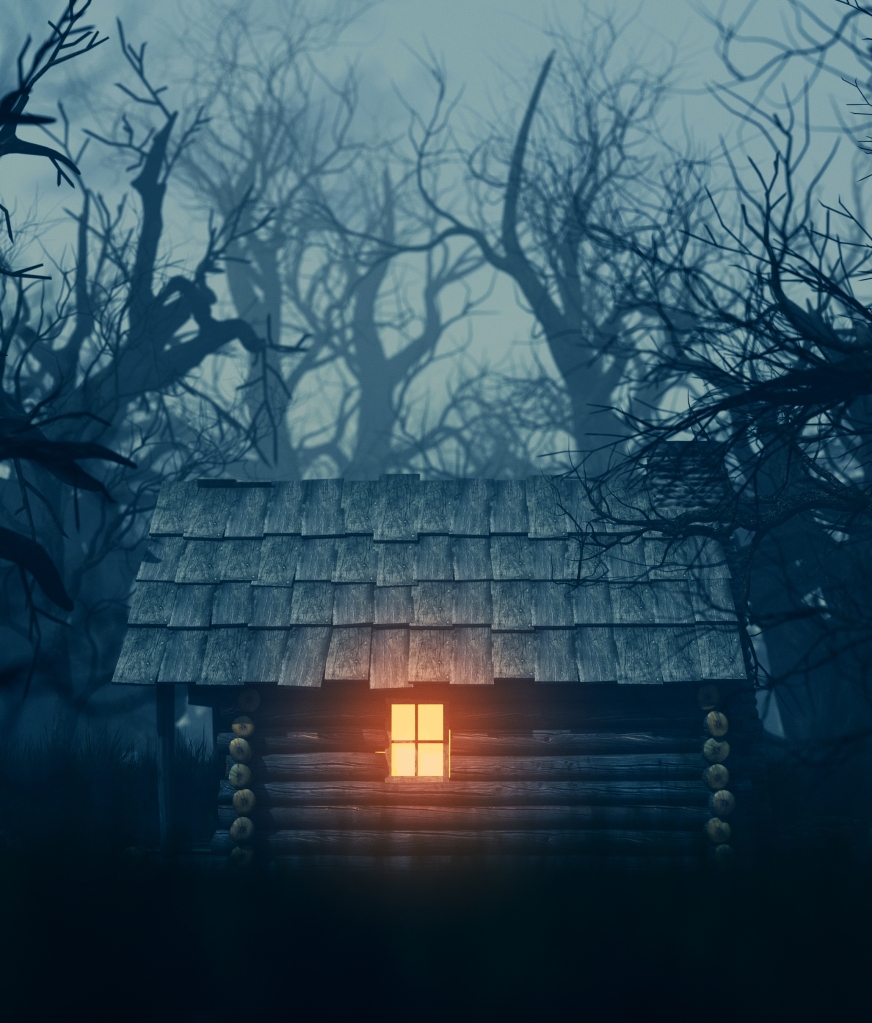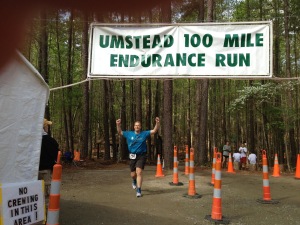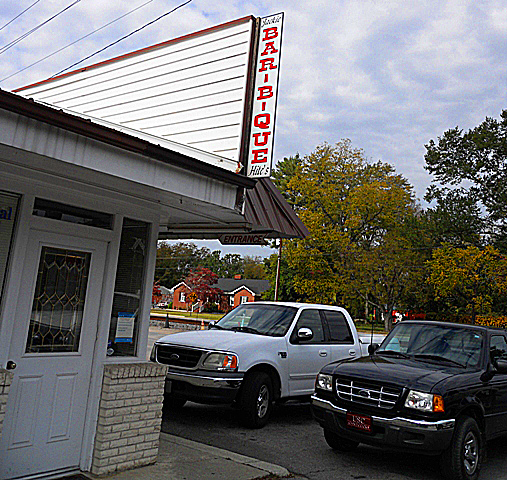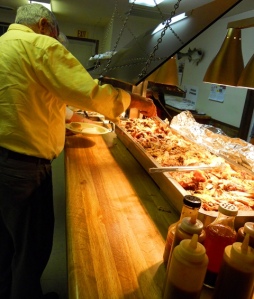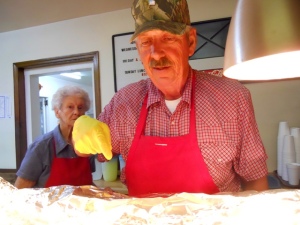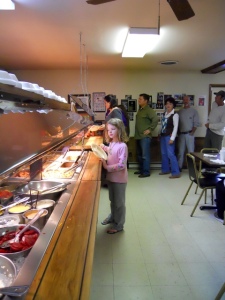
By Teri Saylor
(Note: This article was previously published in the April 2018 issue of The Running Journal)
Last January (2018), Maureen Bowen had found, on the warm sands of Waikiki Beach, a large rock to rest on. It was her last day in Honolulu before she was scheduled to fly to Maui for a half marathon, the 46th state she had to conquer in her quest to complete a half marathon in all 50 states – for the second time.
“I’m sitting on a rock on Waikiki Beach. I had my journal. I had an organic smoothie,” she said. “I was thinking this was an awesome place to write in my journal, and two minutes later everybody’s phones went off around me.’”
A text message alerted her to a ballistic missile strike that seemed inevitable at the time.
It’s early February, and I’m sitting in a Raleigh restaurant with Maureen. We’re munching on a light dinner as she discusses the crazy journey that has made her into a runner – and a survivor.
After losing 100 pounds, completing a half marathon in 50 states, which was almost thwarted when she was hit by a car during a race, running three ultra-marathons, including covering 50 miles of the Umstead 100-Mile Endurance Run while suffering from two different types of cancer, Maureen was still going. She had endured two surgeries, several rounds of radiation and six months of chemotherapy. The Maui half marathon was going to be her big comeback race and suddenly, with the ring of a text message, she thought her world was coming to an end once and for all.
Maureen, 53, who lives in Raleigh, describes herself as a good athlete during her growing up years in Indianapolis. She excelled in softball and won a college scholarship to pitch for Indiana University-Purdue University in her hometown. But after graduating from college she hung up her ball glove and got on with her life – for two decades.
Then she took up running to improve her health.
“I didn’t do my first half marathon until I was 42,” she said.
She started out walking, and completed her first half marathon – the former Mardi Gras Marathon/Half Marathon in New Orleans in 3:45. She finished her second half marathon in 3:15. Then she got the bug.
“At that time, I wasn’t crazy, as I say I am now,” she said. “I would do two half marathons in a year and think that was a lot, and now, if I don’t do two in a weekend, people look at me like ‘what’s wrong with you?’”
Maureen’s life as a casual runner changed when she met Eric Johnson, a well-known Raleigh runner who has a prolific resume of over 200 marathons, including marathons in all 50 states.
“He was telling me about finishing his 50th in Alaska, and I started thinking,” Maureen said. “I had done a half marathon in Indy when I lived there. I did one in North Carolina, I did one in Florida, and while I was sitting there adding up my races the whole time he was talking to me, I realized I had eight states and I thought ‘I could do this.’”
 She was 45 when she set her goal to finish 50 half marathons in all 50 states by her 50th birthday. She had a special race bib made, and every time she finished a state, she noted it on that bib.
She was 45 when she set her goal to finish 50 half marathons in all 50 states by her 50th birthday. She had a special race bib made, and every time she finished a state, she noted it on that bib.
When Maureen says she “caught the running bug,” she’s not kidding. She focused like a laser beam on her 50 states and like a freight train, she barreled through those states, finishing two years ahead of schedule.
“One year I did 34 half marathons and finished 30 states in a year,” she said.
Finishing 30 states in a single year puts you on the highest level of the Half Fanatics organization, she explained.
The Half Fanatics is part of the Marathon Maniacs organization whose members measure their level of craziness in how many races they complete during a designated amount of time.
“The highest level of craziness is 30 states in a year, or 52 half marathons, no matter where,” she said.
Maureen’s goal to reach the Half Fanatics’ loftiest level of craziness was nearly thwarted when a car hit her just three miles into her 29th state in St. Louis, Mo. She happened to be closing in on her deadline to finish her 30th half marathon in one year and couldn’t afford to waste a single race.
“It was icy, and a gentleman was driving very slowly, but he slid and hit me from behind, and I went up on the hood of his car and came off on the other side. The poor man was more upset and petrified than I was,” she recounted. But she convinced the driver she was okay and kept going.
“I didn’t get hurt, and I was at the 5K mark and if I had stopped, I would have missed my goal,” she said. “He said someone needed to come pick me up and I said ‘no, they’re not.’ I’m going to finish this race, and I did. I wasn’t even last. I finished in under three hours. So now if anyone ever asks me if I have ever been hit by a car and still finished a race I can say ‘yes, I have.’”
It’s not just setting goals that fuels Maureen’s fire and keeps her running. She runs for her health, and she runs to prove the haters wrong, first losing 100 pounds and then fighting social stigmas that often come with the extra pounds.
“I was running well, and I had lost a lot of weight, so I was excited to go to athletic apparel stores and buy clothes that would fit me,” she said.
So she picked out Athleta in a local mall and encountered a sales clerk who appeared to be her own size. She wanted a pair of compression shorts, and asked if the store carried them in her size. The sales clerk responded by calling Maureen “a fluffy girl” and reported they didn’t carry shorts in her size.
“That bugged me because I had accomplished this big weight loss, and I felt like I could go shopping in that store, and because they didn’t have the inventory, I was called ‘fluffy,’” Maureen said.
And thus, “Team Fluffy Runners” was born. So many of Maureen’s friends have joined her in solidarity, she is branding the name and taking orders for special “Team Fluffy” athletic clothes, including visors, hats, sparkle skirts and shorts.
Eventually, Maureen set her sights on completing an ultra-marathon. Many of her friends had run 100 miles in the Umstead 100-Mile Endurance Run, so she trained hard, putting in the miles as she ran loop after loop in the park on weekends. On the big day, dehydration led to nausea and she settled for a metric century (62 miles) on that day.
She knew she could do better than that, so five weeks after her first attempt in Umstead, she put on her determination hat, snuck out of Raleigh without telling anyone what she was planning, and completed a 100-mile run in Greenville, S.C.
Last spring, Maureen returned to Umstead, determined to finish. She felt strong and happy, even though she was scheduled for surgery two days after the race to remove an early stage breast cancer. During the first quarter of the race, she started feeling symptoms of a urinary tract infection, and after covering 50 miles, she had to stop.
A month after her surgery, she was starting to run again, but the stubborn UTI would not go away, and doctors feared she had appendicitis. An MRI led to a diagnosis of stage 3 ovarian cancer.
“So now I feel kind of good about Umstead, even though I only finished 50 miles and didn’t make my goal,” she said, in her typical glass-half-full attitude. “How many people have had breast cancer and ovarian cancer and still ran and walked 50 miles?”
Maureen did well with her chemotherapy, continuing to work as a product expert during her treatment, and walking whenever she felt like it.
Maui was to be her comeback. She was ready for it.
Then she was on the beach with other tourists when the text messages started.
“Everybody’s phones went off, and we kind of looked at each other like ‘is this for real?” she said. “And then you think about it and knowing the global political climate, you think well yes, it could be real,” she reasoned.
So she gathered her things and started searching for a place that seemed safe. She chose a parking deck next to a spa at a nearby hotel. With no experience in dealing with ballistic missiles, she reasoned the destruction could be like a tornado.
“If it’s nuclear, we’re all going to go anyway, and there’s nothing we can do about that, but if it’s shrapnel, this concrete on the ground floor of the parking deck is the best place I could be,” she said.
While she was concerned, she wasn’t afraid, and at the same time she was skeptical.
“We didn’t hear sirens go off, only the phones, and so I think it would have been a much more escalated environment if people had heard the sirens,” she said.
A hotel employee came out and saw her hunkered down in the parking deck and asked her what she was doing there. After Maureen explained she thought she was in a safe place should a missile strike happen, the worker left and came back about 20 minutes later to tell her it was a false alarm. A few minutes after that, she received another text message cancelling the alert.
She was incredulous.
“For about 10 seconds after the alert I thought ‘are you kidding me? I went through breast cancer, which escalated into ovarian cancer, and now a ballistic missile? Are you kidding me? Can I just have tomorrow? Can I just get this race tomorrow?”
In the end, she did. She walked the entire race with a friend. She has four more states to go to complete her second round of 50 states, and plans to wrap up the series in Fargo, N.D. in May.
Barring getting swept away in a tsunami, she should be good to go.



